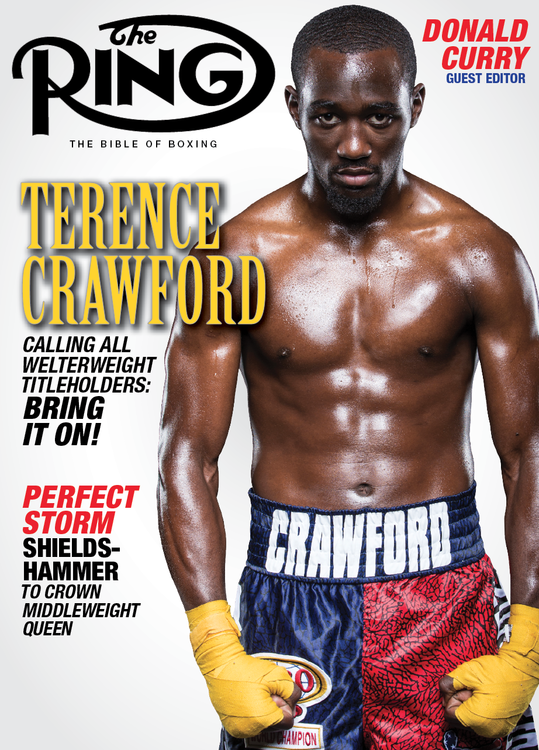The Travelin’ Man goes to ‘ShoBox’ at Sam’s Town: Part Two
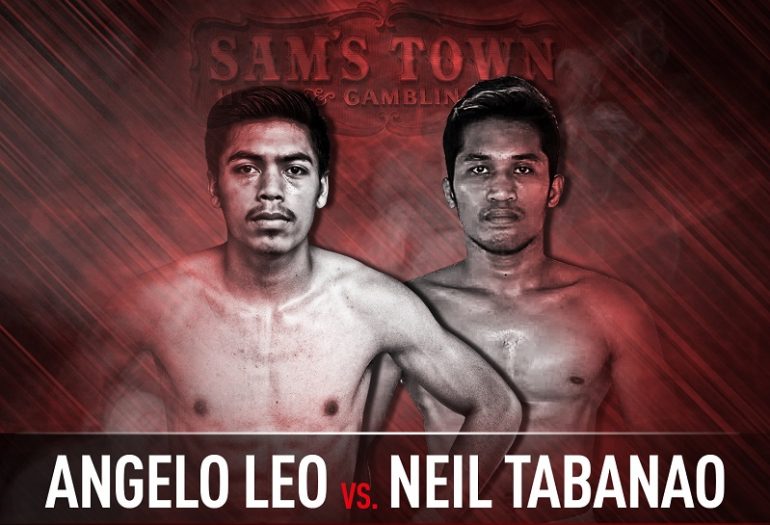
Please click here to read Part One.
Friday, April 5 (continued): In a year that has produced its share of surprises, the most surprising result occurred on this “ShoBox: The New Generation” tripleheader: The expected.
All three perceived “A-side” fighters won as Mayweather Promotions stablemates Andres Cortes, Xavier Martinez and Angelo Leo prevailed over Jahmal Dyer, John Vincent Moralde and Neil John Tabanao, respectively, in impressive fashion. CompuBox colleague Dennis Allen and I predicted that we would see 22 rounds of action and we were treated to 21. Even the nature of the results was well within conventional wisdom – Cortes UD 8 Dyer, Martinez TKO 3 Moralde and Leo UD 10 Tabanao. The only wrong guess I made was that Martinez would take four rounds to stop Moralde and he ended up doing it one round sooner.
ShoBox analyst Steve Farhood accurately stated at the top of the broadcast that the trio of prospects shared many similarities beyond their promotional company, such as their undefeated records, their frequent appearances at Sam’s Town Hotel and Gambling Hall and the fact that Cortes and Leo campaigned in the same weight class and, because of that, there is a temptation to see them as a group rather than as individuals. For that reason, the trio’s objectives for this evening were expanded beyond winning their fights; each needed to create the most positive impression possible while also separating himself from his colleagues. While I liked what I saw from all three prospects, one achieved these tasks better than the others – Xavier Martinez.
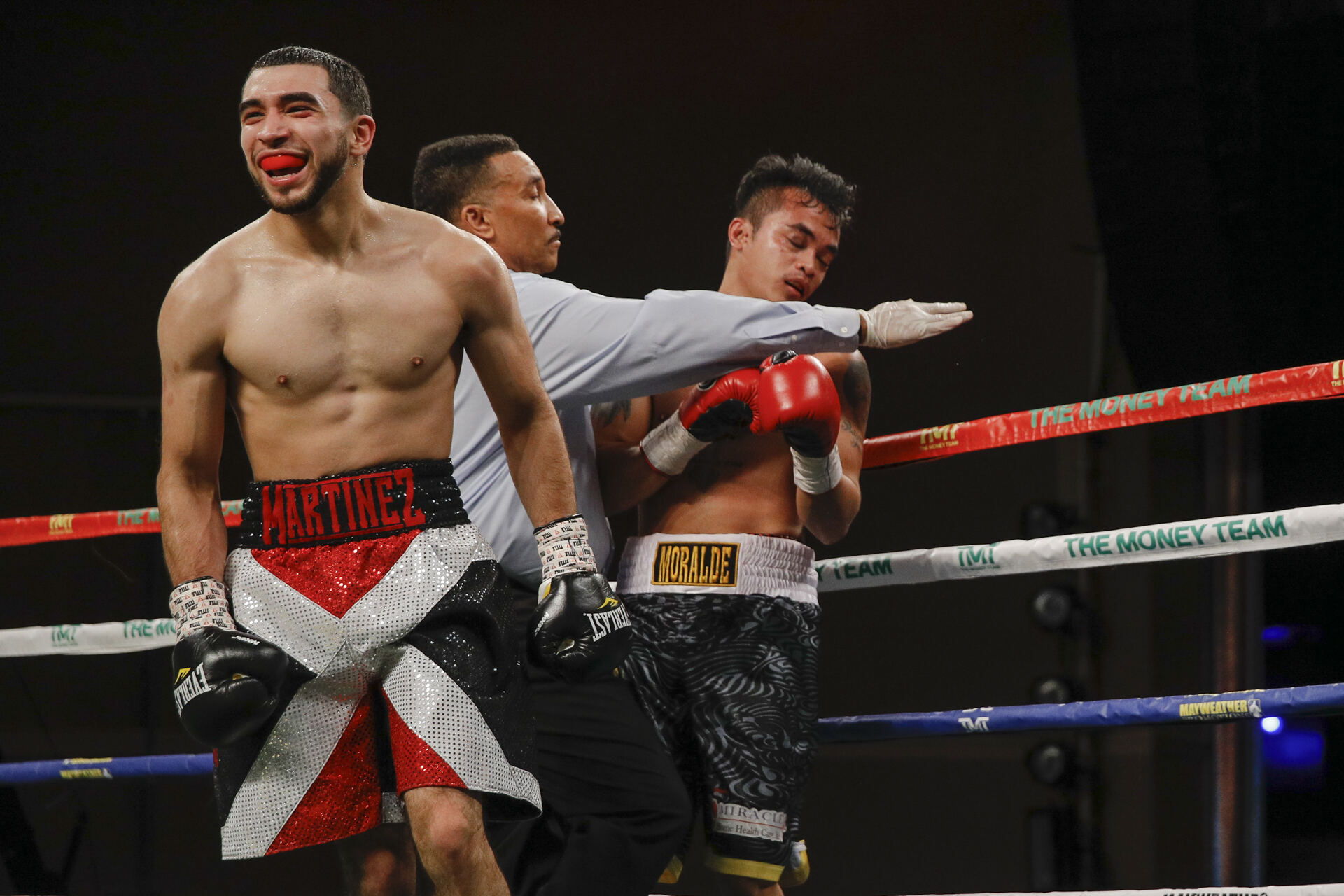
Xavier Martinez (left) vs. John Vincent Moralde. Photo by Esther Lin/SHOWTIME
Martinez said before the bout that he wanted to steal the show and, against Moralde, he delivered in a big way as he hammered the Filipino from start to finish. A crunching hook to the jaw scored a knockdown in the third, after which a power flurry prompted referee Tony Weeks to intervene at the perfect moment. The CompuBox numbers further illustrated the degree of his dominance inside the ring: Averaging 94.1 punches per round to Moralde’s 56.9, Martinez prevailed 91-20 in overall connects, 13-3 in landed jabs and 78-17 in power connects, as well as 40%-15% overall, 15%-6% jabs and 56%-20% power. In the two completed rounds, Martinez recorded 37 and 43 connects to Moralde’s seven and nine and he exploited Moralde’s vulnerability to sustained body punching by leading 31-4 in body connects. Above all that, Morales displayed confidence, ferocity and power that proved far too much for Moralde. A strong case could be made that the first and second rounds merited 10-8 scores even without a knockdown; Martinez landed nearly as many power punches in the first round (31) as Moralde tried to throw overall (32), while round two saw Martinez prevail 43-9 in overall connects and 40-8 in landed power shots. Finally Martinez closed the show in emphatic fashion, after which he triumphantly pointed at analyst Raul Marquez, who predicted during the opening segment that Martinez would shine brightest among the three prospects. Granted, Moralde had lost two of his last four fights but in those defeats against Toka Kahn Clary and Jamel Herring, he went seven and 10 rounds, respectively, while Martinez destroyed him in more than half the time.
In Part One, I said the result of the TV opener between Cortes and Dyer would be determined by distance and volume; Cortes would win if he could force a firefight in the trenches, while Dyer needed to impose a modestly paced thinking man’s match. Dyer couldn’t have asked for a better round one as he out-landed Cortes 8-6 overall (including 6-0 in landed jabs) while throwing 48 punches to Cortes’ 29 and keeping the power punch attempts way down (16 for Cortes, 14 for Dyer). Starting in round two, however, Cortes imposed his kind of fight as he closed the gap, escalated his work rate while forcing Dyer to increase his (Cortes threw 67 punches to Dyer’s 75) and induced more power punch attempts (32 for Cortes, 35 for Dyer). Yes, both men landed 16 total punches and 12 power shots but Cortes succeeded in flipping the script, so much so that even when Dyer scored a flash knockdown in round four, Cortes appeared to have won the rest of the round convincingly enough to merit a 10-9 deficit instead of the usual 10-8. The evidence: Cortes out-landed Dyer 29-9 overall, 9-4 jabs and 20-5 power and created accuracy leads of 32%-14% overall, 21%-12% jabs and 43%-17% power. Cortes earned scores of 79-73, 78-74 and 78-73 from Patricia Morse Jarman, Glenn Trowbridge and Kermit Bayless, respectively, and, as is usually the case, the stats backed up the scores. Cortes was the busier man (65 punches per round to Dyer’s 59.8), the fighter who landed more in all phases (159-72 overall, 45-35 jabs, 114-37 power), the fighter who created the better accuracy gaps (31%-15% overall, 19%-13% jabs, 41%-19% power) and, despite his height and reach deficits of three inches and seven-and-half inches respectively, the better jabber as he averaged 24.1 attempts and 4.5 connects per round to Dyer’s 27.9 and 3.5. The CompuBox round-by-round breakdown of total connects – relevant because clean punching is a key judging factor – saw Cortes ahead 6-1-1, thanks to his sweeping the final six rounds.
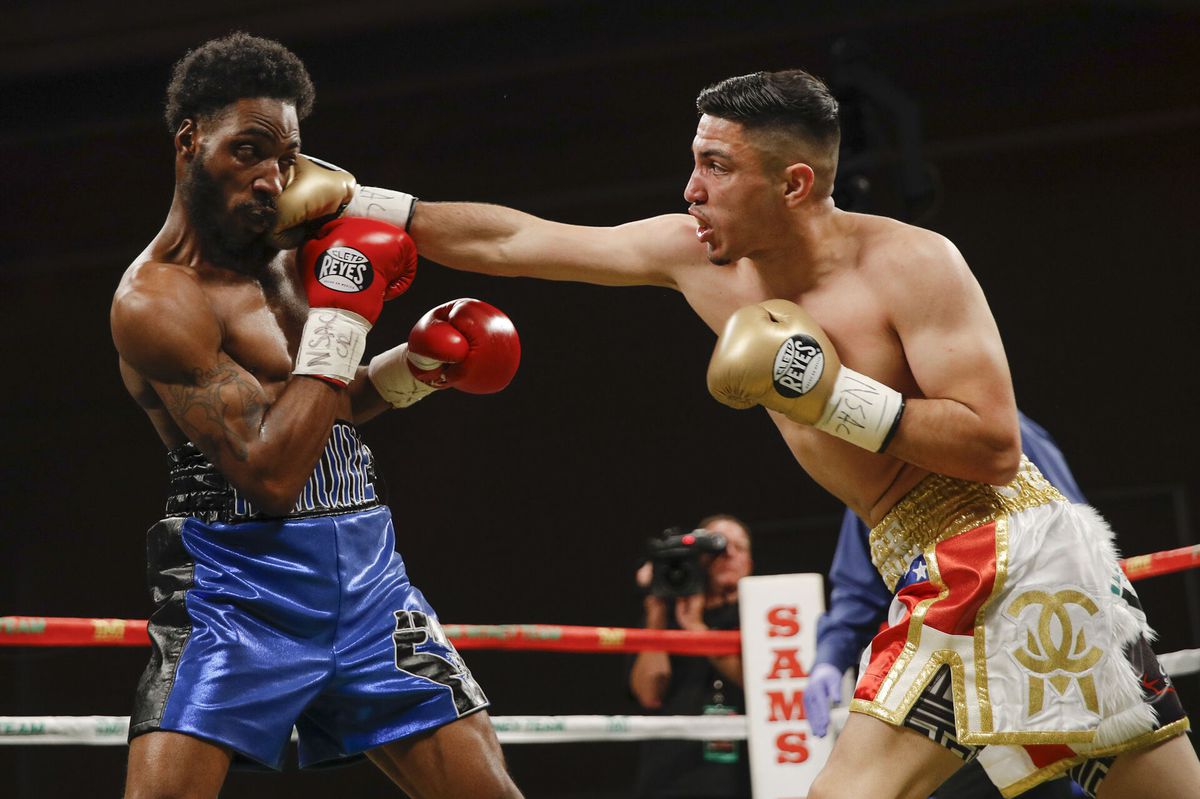
Andres Cortes (right) vs. Jahmal Dyer. Photo by Esther Lin/SHOWTIME
The main event saw Leo rise to a trio of challenges – being the main event fighter in his national TV debut, going the 10-round distance for the first time in his pro career and doing so against his best opponent to date. Had it not been for Martinez’s lights-out performance, Leo would have been the fighter everyone would have been talking about the following morning because there was much to like about his performance. Statistically speaking, he controlled the pace by averaging 54.9 punches per round to Tabanao’s 33.5, neutralized the taller Tabanao’s jab (he averaged just 11.1 attempts and 1.6 connects per round), out-landed him 168-66 overall and 159-50 power to offset Tabanao’s slim 16-9 lead in landed jabs, connected more accurately (31%-20% overall, 42%-22% jabs to counterbalance Tabanao’s 14%-5% edge in jab precision) and limited Tabanao to single digits in total connects in every round, while also prevailing 76-22 in landed body punches. To me, however, the most encouraging sign of Leo’s progress was how strong he finished the fight against a man who had gone 10 or more rounds six times, including three 12-rounders. In rounds eight through 10, Leo out-landed Tabanao 81-20 overall and 79-17 power while averaging 80.3 punches per round to Tabanao’s 35.3. His ninth-round performance was especially productive as he led 38-5 overall and 38-3 power while landing 44% overall and 53% power to Tabanao’s 16% and 11% respectively.
However while Leo shined in the late rounds, it also brought up the possibility that future stoppages may result more from attrition than blunt force trauma because, despite his great numerical success in the late rounds, he was unable to floor Tabanao. To be fair to Leo, however, it must be pointed out that all of Tabanao’s five losses were by decision, including a 12-round loss to confirmed puncher Isaac Dogboe in August 2016. For those reasons, the jury is still out on whether Leo can add sock to his science as he moves up the ladder.
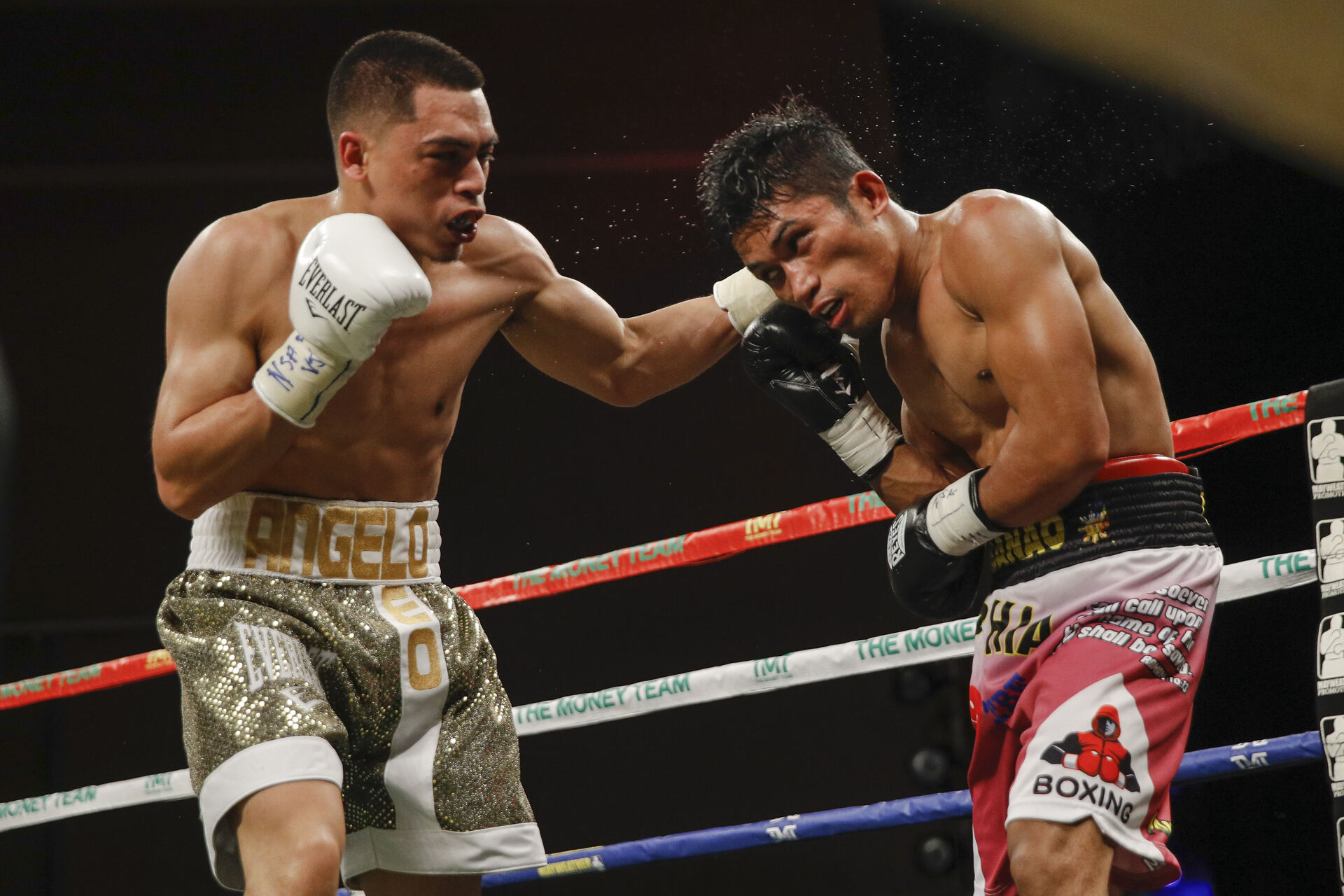
Angelo Leo (left) lands a left hook on Neil John Tabanao. Photo by Esther Lin/SHOWTIME
Thanks to CompuBox’s association with the new “Showtime Pick ‘Em” game linked with Draft Kings, my night’s work was nowhere near over. I needed to get the stats into the master database as quickly as possible and I managed to get the main event numbers uploaded before my internet connection to the truck was cut. After grabbing a quick post-fight sandwich, I zoomed to my room to complete the task, after which I notified everyone that the numbers were ready to use.
Once my work was finished, I wound down by catching up on all the news and sports I missed, then turned out the lights shortly after 11 a.m.
Saturday, April 6: What mattresses and pillows are being used inside the hotel rooms at Sam’s Town? If it weren’t for the fact that stealing is wrong and that neither would fit inside my luggage, I would take them home with me because, for the second straight night, I slept extremely well and restfully. Longtime readers of the Travelin’ Man Chronicles know of my struggles to sleep both at home and on the road and it’s the rare night when I get one night’s worth of good sleep, much less two in a row.
I learned upon checking out that the hotel used Serta mattresses and that while they aren’t contracted to “My Pillow,” the pillows they do use apply the same principles of head and neck support and of keeping its shape no matter what. Yes, the right quad muscle strain I incurred bowling the other night was still there but I was otherwise bright and chipper.
I had planned to awaken at 5 a.m. with an eye on leaving the hotel by 6 and arriving at the airport by 6:30 but after checking out, I learned that taxis don’t usually hang out outside off-Strip properties like Sam’s Town. As a result, one of the hotel employees called a taxi, which arrived shortly after 6:30.
Pranjit, my taxi driver, told me in unaccented English that he was from India and the only Indian boxer I could think of in terms of a conversational ice-breaker was three-time Olympian Vijender Singh, a 33-year-old welterweight currently 10-0 (with 7 knockouts), whose anticipated April 12 U.S. debut was pushed back due to an injury he suffered during sparring in Los Angeles. Pranjit knew nothing of him but his interest was piqued when I told him I worked with CompuBox. When he asked how I was able to get a job with CompuBox, my answer (contained in the following link https://www.ringtv.com/485968-travelin-man-returns-cincinnatiagain-part-two/) took me the rest of the ride to explain. I never tire of telling this story because (1) it is so improbable; (2) it illustrates the power of faith, self-belief, hard work and opportunism and (3) it marked the end of a decades-long pursuit of a boxing-only professional existence, an existence that I hope will continue until my final days on Earth.
I arrived at the airport at 7 a.m., and my first order of business was to secure a Business Select upgrade. Even though my frequent flier number was on the boarding pass and despite the fact I checked in precisely at the start of the 24-hour window, I somehow drew position “C-38” in the boarding line, which meant that I was ahead of only 21 other passengers. How could this be?
I had hoped to rectify this issue at the Southwest counter because there I could pay in cash but the shortest line still would have required a lengthy wait. So in the interest of saving time, I decided to go through security with my current boarding pass and hoped the issue could be addressed at the gate.
Thankfully it was: For a $50 charge on my credit card, I moved up from C-38 to A-10. I learned that Business Select seats are sold in sequence and because seats are sold up to A-15, I realized that I had comfortably gotten under the wire.
We passengers are sometimes asked to look after one another and one such example took place just after I walked through the metal detector and waited for my bags to emerge from the X-ray. For whatever reason, the boarding pass for the man two places ahead of me in line fell out of his luggage during his bag search and was on the conveyor belt apart from everything else. As it rolled out the other side, the man to my right asked if that pass was mine. It was not but another person said it might belong to the man standing 15 feet beyond us. I grabbed the pass, called out the name printed on it and, wouldn’t you know it, that man turned around and said it was his. “Thank yous” were passed all around and, at least for a moment, all of us were linked by circumstance. Once that moment passed, however, we split up and proceeded to our various gates. It’s extremely likely that none of us will see each other again and, even if we do, none of us will recognize any of the others. But for that slice of time at least, we were involved in an episode of benevolence.
Once I settled my business at the gate counter, I found an empty seat and asked the two young women occupying the other two if it was taken. When they said no, I gladly settled in. Oddly the discussion was about Arizona’s unique time zone situation (some parts of the state stay on the same time throughout the year while others shift from Standard to Daylight Savings and back) and the confusion that comes from it. Having known the late Joe Carnicelli (a Brooklynite who moved to Phoenix), I offered my thoughts on the subject and hoped I offered some clarity for them. That led to another conversation in which I learned they were three members of a six-woman bachelorette party and that the young woman to my immediate left (a lovely redhead) was the bride-to-be. The big day will be May 25 – a date which virtually everyone else associates with Memorial Day weekend but I, as a boxing historian, instantly linked it with the anniversary of the controversial Muhammad Ali-Sonny Liston rematch. A bad omen? I hope not but, in any case, given the audience and the situation, I refrained from mentioning the link.
I used my vastly improved place in line to grab a window seat in row eight and was soon joined by two male passengers, one in his 30s and one in his 60s. Both were friendly and talkative but we retreated into our own little worlds once the final safety instructions were read over the intercom. As was the case two days earlier, we were told about the possibility of turbulence upon takeoff and landing but, in reality, it occurred throughout the flight, especially the middle portion where it was so severe that the flight attendants twice suspended their food and beverage service. The pilot later told us that the bobbing and weaving was unavoidable because “bad air” was present at all altitudes.
Still, we landed in Pittsburgh ahead of schedule, and my drive home was pleasingly uneventful. I pulled into the driveway shortly before 6:30 p.m. and, after checking my email, I learned that three fights on the April 13 FS1 show had changes in opponents and would require me to work up new statistical packages. Last-minute fallouts have long been par for the course in boxing, so all I could do was get as much of the job done as I could and move on to the next task. For most of us, this is what life is about and if you can enjoy it along the way, all the better.
I only have a few days to chip away at the “to do” list before preparing for my next journey, which will take me to Atlantic City to chronicle the card topped by the historic showdown between Claressa Shields and Christina Hammer for the undisputed female middleweight championship.
Until then, happy trails!
*
Lee Groves is a boxing writer and historian based in Friendly, West Virginia. He is a full member of the BWAA, from which he has won 16 writing awards, including two first-place awards, since 2011. He has been an elector for the International Boxing Hall of Fame since 2001 and is also a writer, researcher and punch-counter for CompuBox, Inc. He is the author of “Tales from the Vault: A Celebration of 100 Boxing Closet Classics” (available on Amazon) and the co-author of the newly released book “Muhammad Ali: By the Numbers” (also available on Amazon). To contact Groves about a personalized autographed copy, use the email [email protected] or send him a message via Facebook.
Struggling to locate a copy of The Ring Magazine? Try here or
Subscribe
You can order the current issue, which is on newsstands, or back issues from our subscribe page.



